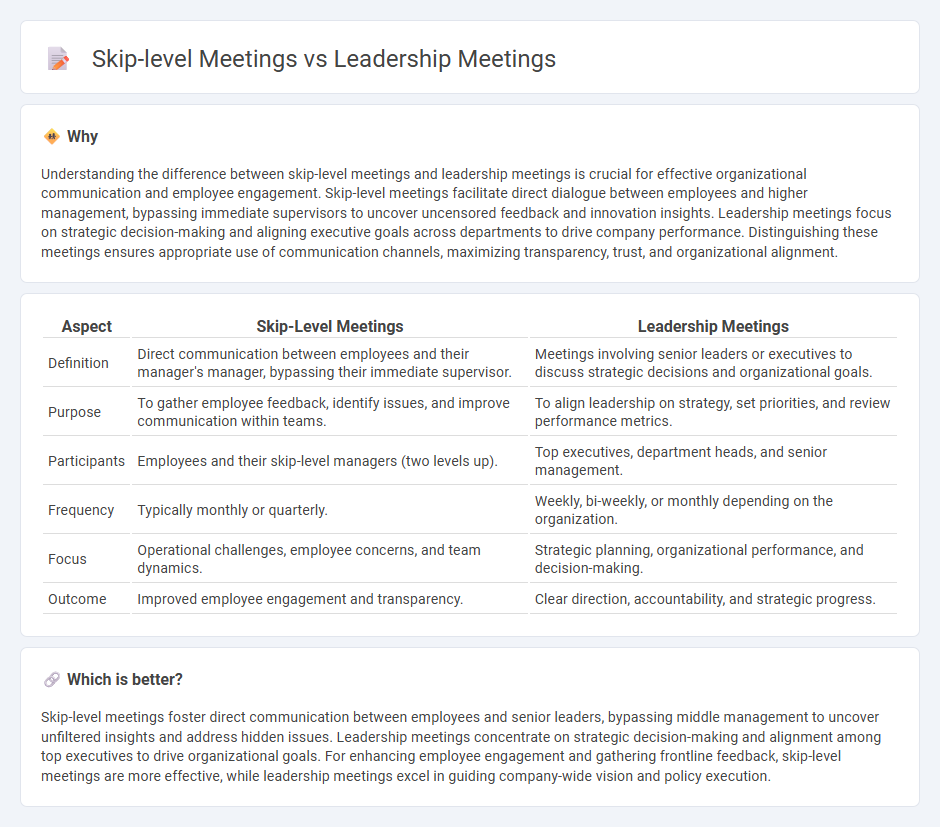
Skip-level meetings provide direct communication between employees and senior leaders, bypassing immediate supervisors to uncover insights on workplace challenges and opportunities. Leadership meetings focus on strategic decision-making and aligning organizational goals among senior management teams. Explore how these meeting types enhance organizational communication and effectiveness.
Why it is important
Understanding the difference between skip-level meetings and leadership meetings is crucial for effective organizational communication and employee engagement. Skip-level meetings facilitate direct dialogue between employees and higher management, bypassing immediate supervisors to uncover uncensored feedback and innovation insights. Leadership meetings focus on strategic decision-making and aligning executive goals across departments to drive company performance. Distinguishing these meetings ensures appropriate use of communication channels, maximizing transparency, trust, and organizational alignment.
Comparison Table
| Aspect | Skip-Level Meetings | Leadership Meetings |
|---|---|---|
| Definition | Direct communication between employees and their manager's manager, bypassing their immediate supervisor. | Meetings involving senior leaders or executives to discuss strategic decisions and organizational goals. |
| Purpose | To gather employee feedback, identify issues, and improve communication within teams. | To align leadership on strategy, set priorities, and review performance metrics. |
| Participants | Employees and their skip-level managers (two levels up). | Top executives, department heads, and senior management. |
| Frequency | Typically monthly or quarterly. | Weekly, bi-weekly, or monthly depending on the organization. |
| Focus | Operational challenges, employee concerns, and team dynamics. | Strategic planning, organizational performance, and decision-making. |
| Outcome | Improved employee engagement and transparency. | Clear direction, accountability, and strategic progress. |
Which is better?
Skip-level meetings foster direct communication between employees and senior leaders, bypassing middle management to uncover unfiltered insights and address hidden issues. Leadership meetings concentrate on strategic decision-making and alignment among top executives to drive organizational goals. For enhancing employee engagement and gathering frontline feedback, skip-level meetings are more effective, while leadership meetings excel in guiding company-wide vision and policy execution.
Connection
Skip-level meetings enhance organizational transparency by allowing leaders to engage directly with employees two or more levels below, complementing leadership meetings focused on strategic decision-making. These meetings foster open communication, uncover operational insights, and align frontline perspectives with leadership objectives. Together, skip-level and leadership meetings strengthen management effectiveness by bridging hierarchical gaps and promoting informed, cohesive leadership.
Key Terms
Decision-making vs. Communication flow
Leadership meetings center on strategic decision-making, aligning team goals, and steering organizational direction. Skip-level meetings prioritize open communication flow by fostering direct dialogue between executives and team members, bypassing immediate supervisors to surface insights and concerns. Discover how integrating both meeting types enhances overall leadership effectiveness and organizational transparency.
Direct reports vs. Indirect reports
Leadership meetings primarily concentrate on direct reports, enabling leaders to discuss their team's performance, provide feedback, and align on goals. Skip-level meetings focus on indirect reports, fostering open communication channels and gaining insights that might not surface in regular hierarchical discussions. Explore how optimizing both meeting types can enhance organizational transparency and employee engagement.
Agenda setting vs. Relationship building
Leadership meetings prioritize strategic agenda setting to align organizational goals, drive decision-making, and ensure accountability among senior teams. Skip-level meetings emphasize relationship building, fostering open communication and trust between leaders and employees two levels below to uncover insights and feedback. Explore effective practices to balance both meeting types for optimized leadership impact.
Source and External Links
Run Effective Leadership Meetings - This article discusses the importance and types of leadership meetings in aligning leadership and driving organizational success.
The CEO's Guide to Running Effective Leadership Team Meetings - Offers guidance on planning and organizing leadership team meetings to focus on strategy and decision-making efficiently.
Leadership Meetings: How to Run Them in 2025 - Provides tips and insights on conducting effective leadership meetings, including agenda planning and information sharing.
 dowidth.com
dowidth.com